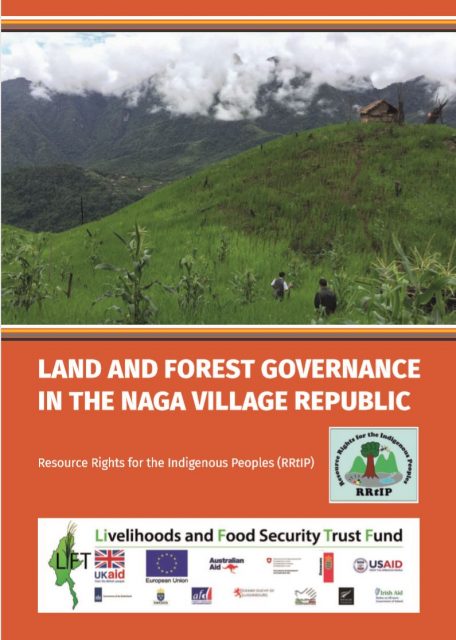Executive Summary
The Nagas are a trans-boundary people, comprised of over 40 tribes, living in the Naga Hills split between north-east India and north-west Myanmar. Naga people have deep historic, cultural and spiritual ties to their land, which is managed through the Naga customary tenure system. The customary tenure system defines who can use and manage different resources, including households, clans, villages and tribes – and provides rules for how they should be managed. Customary institutions, from the village council and village chief to tribal councils and intertribal organizations, have responsibility for setting and enforcing these rules. The customary justice system provides a framework to resolve disputes through mediation and enforce village rules with penalties and fines. Together, customary laws and institutions ensure a diverse and sustainable land use system that provides for livelihoods and food security, adaptively manages resources, protects the environment and maintains cultural and religious traditions.

Throughout Naga history, the village has been the primary political, social and administrative unit. Within village boundaries, residents manage a productive, organic agricultural system, growing a diverse variety of subsistence and cash crops. Jhum cultivation is a sustainable, low-input, diverse rotational agricultural system that is important for food security and uses fallow periods to regenerate soil fertility. Households cultivate terraces and jhum plots and maintain woodlots, while villages manage shared resources like protected watershed forests. These community-managed forests are effectively protected by the customary system, which allows timber and fuelwood extraction for domestic use only and enforces fines for over extraction.
The Naga customary land tenure system also ensures that community members have access to land and use it productively. All land is claimed and managed and there is no vacant land. Households in need of land, including newcomers and people displaced by conflict or natural disaster, are allocated land to cultivate on a yearly basis. When transferring land tenure by inheritance, sale, or when moving away from the village, priority is given first to immediate relatives, then clan members, then other community members. Land is inalienable and cannot be sold to private companies or people living outside of the village.
Customary institutions, primarily the village council and chief, administer the land within village boundaries. Management decisions are made by community members at village assemblies and approved by the village council and chief. Tribal councils, township-level committees, and pan-tribal organizations bring villages and tribes together to resolve disputes, review customary law, and pursue shared goals.
The customary justice system resolves disputes over land through negotiation and mediation by customary authorities and disputes are usually resolved within the village. The system emphasizes reconciliation and maintaining social harmony.
Village authorities – including the village council and chief – enforce land management rules, for example by seizing timber that is harvested without the village authorities’ permission.
Religion and cultural identity are expressed through the customary tenure system. Traditional religious practices are rooted in the land and spirits that inhabit it. Feasts and festivals and traditional religious ceremonies are tied to customary land management, especially the annual cycle of jhum cultivation. Although the adoption of Christianity over the past 150 years has changed and diluted traditional beliefs, traditional culture persists in the relationship to the land.
The customary tenure system also continually develops and adapts to new circumstances by establishing new management institutions, changing village management rules, and reviewing customary tenure, for example inheritance rights for women. Far from being a relic of the past, villages, clans and tribes continue to adapt and strengthen the customary tenure system to meet new challenges.
Despite of the value of the customary tenure system, the current legal framework in Myanmar does not adequately recognise customary tenure. In recent years, customary rights over the land and forests of the Naga people have become more vulnerable than ever, as government institutions enforcing state laws and policies are increasingly being introduced into Naga areas, causing conflict as a result of their incompatibility with the customary system. Expansion of government administration without recognizing customary tenure poses a threat to the livelihood, environment, and culture of the Naga people living in Myanmar.
Sustainable, productive land management in Naga villages cannot be separated from the customary tenure system. Effective recognition of the Naga customary tenure system includes both recognizing land rights and granting appropriate authority to the customary institutions that administer the land. Recognizing the Naga customary tenure system is essential for managing resources sustainably, securing rural livelihoods and creating a stable foundation for peace.
Download full report in English HERE






 The last Konyak headhunters of Nagaland
The last Konyak headhunters of Nagaland What Does Your Face Say About Your Health?
What Does Your Face Say About Your Health? Meet R.N. Ravi, who is mediating peace with the Nagas
Meet R.N. Ravi, who is mediating peace with the Nagas The Top Viral YouTube Videos of 2017
The Top Viral YouTube Videos of 2017









Leave a Reply
Your email address will not be published. Required fields are marked (required)